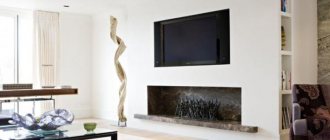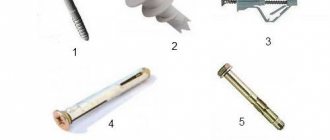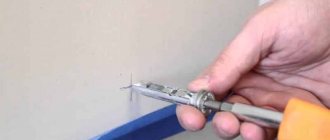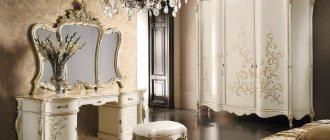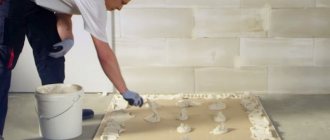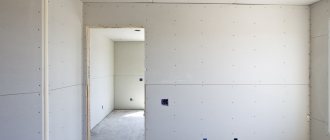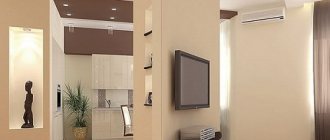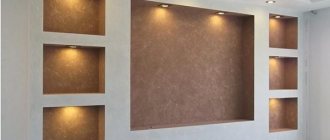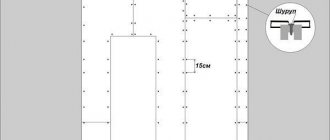Is it possible to hang a TV on drywall?
Yes, you can hang a TV on a plasterboard wall. It will be possible to mount the equipment both with a factory bracket and without a factory mount.
In online articles there is often an opinion that a gypsum board sheet is not able to withstand the load of significant masses. Of course, if you hang several hundred kg, then the single-layer, or even double-layer, cladding will collapse. And the attached object will collapse.
One sheet can easily withstand 10-20 kg without the use of additional structures and parts.
As for TVs, modern models weigh so little that they can even be hung on single-layer drywall. It is more important to use the correct fasteners. It is the dowel that determines how strong the bracket mount and the maximum permissible weight will be.
Mounting TVs weighing up to 30 kg
A small TV with a diagonal of up to 32 inches, the weight of which will not exceed 5 kg, can be hung on top of the gypsum board using a butterfly dowel. The main thing is that the fastener element simultaneously pierces the drywall and the metal sheathing profile. Then the load from the TV will be redistributed from the finishing material to the supporting frame of the structure.
A TV with a diagonal of more than 42 inches can weigh about 20 kg. Such equipment requires a more secure mount. For these purposes, you can use an umbrella dowel. It received this name because of the way it opens in the structure. By tightening while screwing in the screw, it is guaranteed to hold the stated weight, since the weight of the TV will be distributed over a large area. To ensure high-quality fastening, it is necessary to use at least 4 parts.
Television screens weighing from 20 to 30 kg are hung on the wall using the Hartmut mounting system. This is a fastener consisting of plastic and metal elements and a screw. It is ideal for hanging heavy objects, as one product can support up to 55 kg.
When using fasteners for hollow walls, you must remember that after the dowel is installed, it needs to be unscrewed a little to fully open the inside of the system.
What dowels are needed
To secure light objects, such as photo frames, you do not need to use advanced fasteners for heavy weights. All you need to do is screw in a drywall screw and hang a picture or something else.
If you fasten the TV receiver in this way, the screw will pop out of the drywall and the TV will fall to the floor. Therefore, a regular screw should never be used.
You need a special dowel designed for tangible loads.
- Screw dowel for drywall (DRIVA). No pre-drilling of the sheet is required for fastening. A plastic (or metal) dowel has an external thread, which is used to twist and fix it in plaster. The principle of operation is practically no different from an ordinary screw. But the significant difference lies in the area of the thread (screw). Due to the large protrusions, the screw is securely fixed in the sheet and can withstand a load of 5-10 kilograms or more. Not recommended for use on heavy items. A single fastening with a single-layer gypsum board can withstand 5-6 kg, with a two-layer one – up to 15.
- Butterfly dowel. It has a plastic sleeve, which opens when inserted into the hole. And when the screw is tightened, the side lobes of the sleeve begin to attract. By fixing the sheet on the back side, it will be possible to mount heavier TVs. The permissible load on one dowel for a single-layer material is about 10 kg, for a two-layer material – 25 kg. This is the first option that makes it possible to hang a TV on a plasterboard wall without complex reinforcing structures and actions. You just need to drill holes for the diameter of the dowel. Next, the part is threaded through the hole and twisted so that the petals tightly press the back side of the drywall.
- Dowel “Molly” (or “umbrella”). The holding principle is identical to the “butterfly”. Twisting leads to the opening of metal petals that look like an umbrella. Made of metal, which means the maximum load increases. If the sheathing is made of plasterboard in a single layer, then you can hang equipment up to 35 kg on one fastener.
- Dowel Knauf Hartmut (Knauf Hartmut).
The most reliable option for wall mounting a TV on drywall.
Structurally, it is made of metal fasteners, plastic antennae and a pressure ring. The metal strip rests against the back of the wall, forming a support point for maximum area. With one 12.5 mm thick plasterboard sheet, a load of up to 35 kg can be attached. A two-layer plasterboard wall will withstand 55 kg. This means you don’t have to worry about the fastening being unreliable. Fully fastened with a wide mounting plate (rail) of the bracket on drywall will hold even the heaviest TV receiver.
Load values given are not accurate. Sometimes it turns out to hang things much heavier. But there should always be a margin of safety. Therefore, it is better to use the characteristics from fastener manufacturers.
The varieties "Molly", "butterfly" and Hartmut are intended only for hollow structures. This is necessary to insert the support part into the hole. There must be enough space behind the plasterboard sheathing to accommodate the fastening part of the dowel.
If the gypsum board is leaned against the wall without an intermediate frame, you can use a regular plastic dowel and a screw of the appropriate diameter. Both elements must be quite long in order to be securely fixed to the wall. When choosing parts, the thickness of the drywall is taken into account. The main load with this type of fastening falls on the wall (concrete or brick). And the installation technology does not differ from the standard version. First, holes are made in the wall for installing the bracket. Then the dowels are driven in, after which the bracket is secured to the wall with screws. Then the TV is hung on the wall.
Commonwealth of GKL and TV
Drywall is a material that does not have a sufficient margin of safety. Lightweight items aren't that difficult to hang on a wall like this, but an expensive TV is a different matter. The best solution is to plan the location of the equipment in advance. In this case, you can make the necessary preparations while creating the picture. We are talking about built-in rods (boards) that are attached to its metal pegs or to the wall.
How to hang a TV on drywall if such elements were not provided in advance? It should be said right away that ordinary self-tapping screws will not help here, so you will need special dowels. The thickness of the plasterboard structure is of no small importance. A wall covered with 2 layers of gypsum boards can support much more weight compared to a single-layer structure.
Another topic to consider is the weight of the TV and drywall. Technology with a large mass always poses a danger: both for the thinnest wall and for the recipient. Therefore, experts have introduced restrictions: it is better not to try to fix a device weighing more than 30-35 kg on not very hard surfaces. Possible options: strengthen the future “television” wall with a sheet of plywood or make a plasterboard cornice with a reinforced wall.
What kind of bracket is needed
The highest reliability when hanging the bracket is achieved:
- increasing the mounting area;
- using a large number of fasteners.
This means that you need to choose a TV bracket that contains at least 4 points for mounting on the wall. It will be a square or large rectangular version.
The larger the size of the wall plate, the greater the strength of the structure when suspended.
Concrete walls
Before starting installation, it is important to make sure that there are no cables or gas pipelines at the installation site. Position the bracket where it will be mounted and mark where you plan to drill the holes.
After drilling, insert dowels into the holes.
Using a screwdriver, screw the supporting part to the wall surface. Before fully tightening the screws, adjust the horizon of the supporting element with a level. You can begin assembling the product in accordance with the instructions included with the package.
Once installation is complete, place up to 40 kilograms of weight on the mount to test its strength. Then hang the TV on the support, making sure that the mounts are secure and secure.
How to attach to drywall
The installation instructions consist only of correctly marking the wall, making holes and using fasteners.
From the description above, we conclude that the Hartmut model is the most reliable. Fasteners are much more expensive than analogues for use on drywall. But you can’t skimp on fastening. Poor fixation will cause the TV to fall to the floor, which means the screen will break.
- Place the bracket against the base and use the built-in level to level the fasteners. If there is no level on the mount, use a separate water level.
- Use a pencil to mark the circumference of the holes in the bracket for future holes on the plaster wall.
- Use a regular drill to make holes in the drywall. The diameter of the holes must be sufficient to pass through the steel part Har class=”aligncenter” width=”730″ height=”317″[/img]
- After inserting the Hartmut, press the plastic ring as tightly as possible to the hole.
- Bend the tendrils toward the surface of the drywall and break them off.
- Screw on the bracket with bolts.
- Hang up the TV receiver.
If other fasteners are used, for example, the “butterfly” or “umbrella” options, then the principle of operation is the same. The fastening part is threaded into a hole of a suitable size. Next, the screw is tightened tightly to open the sleeve as much as possible and press the sheet from the rear with the petals. Then the bracket is hung, and then the TV on top.
The option with standard hanging through drywall fasteners is the simplest and most reliable. Even if the wall is covered with one gypsum board sheet, the TV will hold firmly and will not fall off.
Two-layer cladding is considered more reliable. In addition to improved sound insulation, the maximum supported weight of the attached item is increased by default.
But if you need to be as safe as possible, you can use more complex installation technologies. Some of them are described below. The methods listed below will ensure that the TV is secured without the risk of the mount collapsing.
How to hang
Before attaching the TV to the wall, you need to familiarize yourself with how it can be hung.
On the bracket
Installation on the bracket is quite easy, but you still need to familiarize yourself with several useful recommendations in advance:
- before you start hanging the TV, you need to carefully study the electrical wiring plan so as not to accidentally touch it;
- if the TV is too heavy, it is better to hang it with an assistant;
- When installing television equipment, it is necessary to take into account the distance for ventilation so that the TV does not overheat.
Without him
Sometimes people are unable to attach the TV to the brackets and have to do it without them.
In this case, you will have to construct the mounting system yourself. To create it, you will need to prepare two pieces of beveled wood in advance. To do this, a block of wood is cut into two equal parts using a circular saw. One of the wooden pieces is attached to the back cover of the TV, and the second is attached to the wall. When installing a TV, wooden blocks are fastened with screws.
If the sheets are not yet attached with screws
It is always recommended to plan the placement of future items and equipment at the renovation stage. Especially if this concerns hinged mounting on non-load-bearing additional walls or partitions (in our case, plasterboard).
The best solution would be to install mortgages. These are wooden bars or boards that are fixed between metal profiles (posts) that form the frame of the wall.
- Profiles of suitable width are mounted between two racks using metal screws. Profiles should not protrude. All connections are made level with the outside of the frame.
- Beams or a solid board are laid into the inner surface of the profiles. The wooden element is attached with screws through the side of the profile.
On a finished wall, mounting holes should be made directly through the gypsum board into the embedded wall.
With individual thin bars there is a high risk of a miss. Therefore, it is better to use a solid wooden board as a mortgage.
It can be secured with the previously mentioned Hartmut dowel or wood screws.
How to install the wiring?
Everyone knows that the room is always equipped with sockets (connection points) that provide the power needed for household appliances. As a rule, they always install not only wall panels, but also other household appliances such as DVD players, video cameras, Wi-Fi routers. For this reason, it is necessary to take into account the load on the wiring and provide for the installation of more connection points. It is possible that you will need to hang additional shelves for placement. Before choosing a location for installation on the wall, be sure to consider how the wiring will run.
Wiring can be of two types.
- Open. This type does not meet high aesthetic requirements, since the cables are routed directly along the surface of the plasterboard walls. But such wiring has an undeniable advantage - it will allow you to complete the repair in a short time.
- Hidden. This type is popular because it makes all the wiring completely invisible to prying eyes, and this increases aesthetic requirements and the room becomes neat. All cable wiring is removed into the ceiling and floor plinths, only the places where they are connected to the outside where necessary remain visible.
Important! The locations of the wiring terminals for connections are organized in advance, at the stage of installation of the plasterboard covering. To connect the installed TV to the power supply, you must first take into account the length of the standard cable of the panel and the distance to the nearest outlet. Using portable extension cords will not make the room more attractive.
Fastening through plasterboard to the main wall
Required:
- hairpin screw;
- dowels with four-sided expansion to the diameter of the screw;
- perforator;
- drill of the required diameter.
The length of the screw must be greater than the thickness of the entire sheathing - profile frame and drywall.
The general mounting diagram is as follows.
- You need to make a hole in the wall for the dowel directly through the plaster sheet.
- Use the sharp end of the screw to screw the dowel 1-2 turns.
- We try to get into the wall hole through the hole in the sheet and perform the initial placement of the dowel.
- We unscrew the screw.
- Screw the nut onto the metric thread. We insert the side with the nut into the hole and, using the power of a hammer, hammer the rod to the end.
- The screw is then screwed into the dowel. Screwing must be done with a regular key. First, you need to screw two nuts onto the back side of the stud and press them together. This will prevent the nut from turning.
- The last step is to fix the bracket on the studs with nuts.
The only difficulty with this method is selecting the correct length of the mounting screw.
Instead of a stud screw, you can use a regular expansion anchor for concrete foundations.
Plasterboard walls with appliances
Agree, there are quite a lot of installation options, and they all provide an acceptable level of reliability, so you can build almost any plasterboard structure for a TV, even without mortgages.
Here is a small selection of designs one way or another related to the installation of equipment:
“How to attach a TV to a plasterboard wall - a video that will show the principles of installing embeds in action. We think anyone can easily deal with dowels anyway.
Technical types of fasteners
There are the following variations of wall-mounted restraints, differing in parameters:
- Fixed. The element fits tightly to the surface and is used mainly for small rooms. The cost of the product depends on the manufacturer, but is usually much lower than that of other varieties. A significant drawback is the inability to change the viewing angle.
- Inclined. A modified variation that is suitable for small and medium-sized rooms. The main difference from the previous model is the ability to change the angle by 15–20 degrees.
- Swivel version with tilt function. Modern universal type. The design allows you to change the position of the TV in the horizontal and vertical plane. But such a modification requires a lot of space for fixation and has significant weight, which requires the use of special installation methods.
Tilt-and-swivel brackets are good for rooms with large square footage and high ceilings; in standard city apartments, inclined and fixed models are often sufficient
Depending on the manufacturer, each type can support a TV of a certain weight; the exact data is indicated in the instructions. When working with gypsum plasterboard surfaces, the fixation method is important: it is recommended to choose devices with a large landing platform.
On a note! Although the accompanying documentation indicates different angles of mobility, they are limited by the diagonal of the screen of the device that is intended to be hung.


